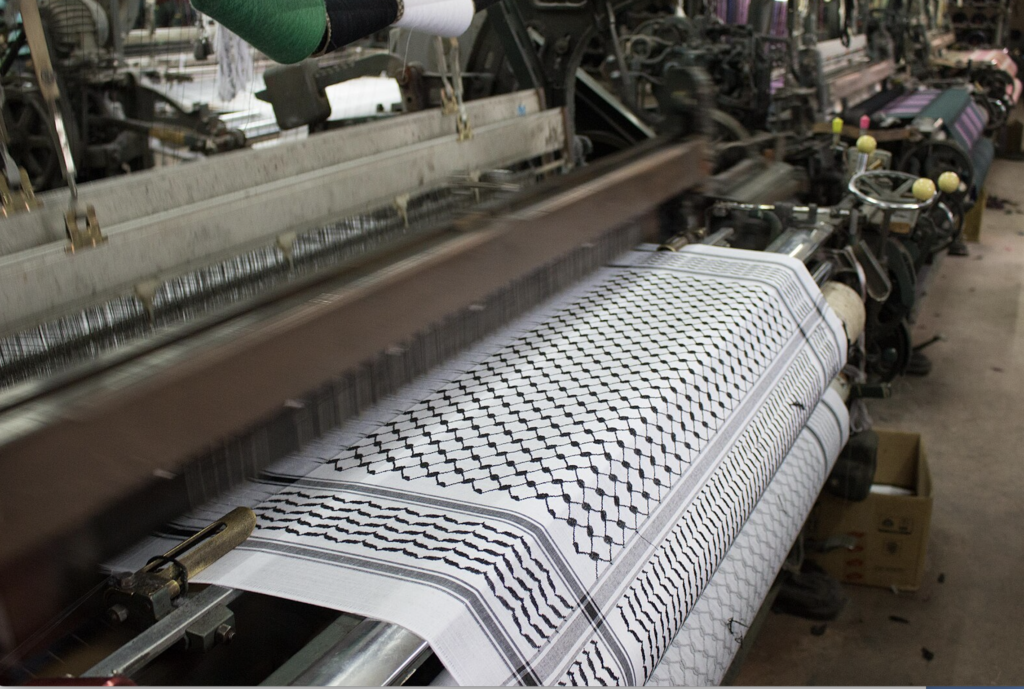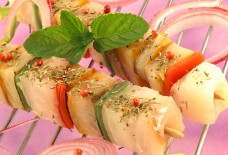The Significance of the Kuffiyeh Throughout History and how that Has Changed in Recent Times

By Monica Haddad / Arab America Contributing Writer
Origins and Meaning:
Although the exact country of origin of the kuffiyeh is not entirely known, historians have dated the scarf all the way back to the 3000s BCE in ancient Mesopotamia where it served to denote priesthood. In Palestine, up until the early 20th century, kuffiyehs were worn mainly by bedouin and nomadic groups who donned the scarves on their heads to both visually display their bedouin identity as well as to protect themselves from the scorching sun and sand in the desert.
The kuffiyeh consists of three different patterns: the fishnet pattern, olive leaves, and the bolded striped lines. Each of these patterns hold strong meaning and significance. The fishnets on the kuffiyeh represent the Palestinian connection to the Mediterranean Sea and the importance of the sea to Palestinian sailors and fisherman. The olive leaf pattern stands to represent the resilience of the olive tree. The olive tree is something that is very important in Palestinian culture and a major agricultural crop native to the land. Olive trees are deeply rooted and withstand hundreds of years of history. Finally, the bolded stripes on the kuffiyeh represents trading routes that exist through Palestine. These trading routes between Palestine and other countries represents the rich cultural that Palestine has to offer and share with the world.
Palestine under Ottoman Rule:
In 19th-century Palestine, under Ottoman Rule, farmers and other lower-class Palestinians wore keffiyehs, while upper-class Palestinians opted to wear a tarboosh, a felt hat adorned with a singular tassel popularized by the Ottomans. During this time, the keffiyeh was a marker of lower-class identity.
Mandate Palestine:
In the 1930s during the British Mandate Period, the class divisions of the kuffiyeh dissolved as Palestinians of all classes donned the kuffiyeh in unity. During the Arab Revolts against the British, the kuffiyeh was worn by Palestinian protesters in order to hide their faces and protect their identities from British officials.
1948-2023:
After the establishment of the state of Israel and the Arab-Israeli war in 1948, thousands of Palestinians were displaced from their homes. The displaced individuals wore the kuffiyeh as a way to represent their resiliency and strength as well as to and serve as a reminder of their ties to the land.
Post October 7th World:
Since October 7th, 2023, it is undeniable that we have been seeing the kuffiyeh more and more. For many Arab Americans, the popularization of the kuffiyeh in the mainstream is a double edged sword. While it can be a positive thing that something so significant to Arab and Palestinian culture is finally getting recognition and appreciation in the West, there is something to be said about the commercialization, polarization, and appropriation of the kuffiyeh that has also come with its popularity. Cotton and wool scarves that were handmade and produced in small factories in Palestine and other Arab countries are now being imitated, cheaply made with synthetic fibers, and mass-produced by fast fashion companies and retail giants like Amazon. Since October 7th it can be argued that wearing the kuffiyeh makes a statement about a person’s solidarity and support for Palestine and the Palestinian people which has caused many individuals to be scrutinized and harassed simply for wearing one.
The kuffiyeh has gone through many symbolic transformations throughout history, serving as a identifier of class and status, a means to protect individuals from the sun, and as a symbol of resistance and national identity. In today’s world, the kuffiyeh and Palestine are indisputably linked, however, it is important to learn the rich history and meaning behind the scarf to understand why the kuffiyeh has become one of the most prominent symbols in the movement to support Palestine.
Visit our blog here!









